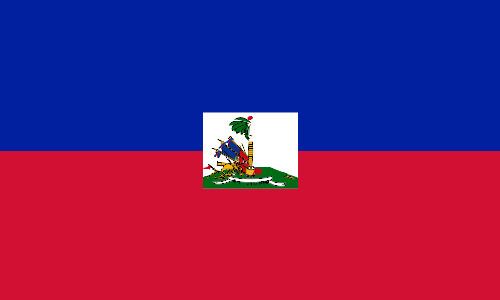Population 10.32 million (2013) Population growth rate 1.4% annual change (2013) | Life expectancy 62.70 years (2012) GNI per capita 1,720 PPP dollars (2013) | |
 | ||
Fertility rate 3.21 births per woman (2012) Official languages French, Haitian Creole French | ||
Although Haiti averages approximately 255 people per square kilometer (650 per sq. mi.), its population is concentrated most heavily in urban areas, coastal plains, and valleys. The nation is multi-ethnic, home to peoples of different races and ethnic groups. 95% of Haitians are of predominantly African descent. The remaining 5% of the population is primarily mulattoes, Europeans, Asians and Arabs. Hispanic residents in Haiti are mostly Cuban and Dominican. About two thirds of the Haitian population live in rural areas.
Contents
- Map of Haiti
- Population
- Structure of the population
- Vital statistics
- Births and deaths
- Fertility and births
- Languages
- Religion
- Education
- Labor
- Emigration
- The World Factbook demographic statistics
- Nationality
- Ethnic groups
- Literacy
- Religions
- References
Map of Haiti
Although there was a national census taken in Haiti in 2003, much of that data has not been released to the public. Several demographic studies, including those by social work researcher Athena Kolbe, have shed light on the current status of urban residents. In 2006, households averaged 4.5 members. The median age was 25 years with a mean average age of 27 years. People aged 15 and younger counted for roughly a third of the population. Overall, 52.7 percent of the population was female.
Population
According to the 2012 revision of the World Population Prospects the total population was 9,896,000 in 2010, compared to 3,221,000 in 1950. The proportion of children below the age of 15 in 2010 was 36.2%, 59.7% was between 15 and 65 years of age, while 4.5% was 65 years or older .
Structure of the population
Structure of the population (01.07.2010) (Estimates) :
Structure of the population (01.07.2011) (Estimates) :
Structure of the population (DHS 2012) (Males 28 122, Females 29 844 = 57 966) :
Vital statistics
Registration of vital events in Haiti is not complete. The Population Department of the United Nations prepared the following estimates.
Disasters often cause human populations to increase long term, rather than decrease, by way of increased fertility exceeding the deaths caused by the initial disaster, as shell-shocked mothers replace every lost child with more than needed. In Haiti's case, the fertility rate nearly tripled after the quake, and is likely to remain elevated (above pre-quake levels) for long after.
Births and deaths
Number of births and deaths are calculated - based on Crude Birth and Death Rates.
Fertility and births
The Total Fertility Rate (TFR) (Wanted Fertility Rate) and Crude Birth Rate (CBR):
Languages
Taíno was the major pre-Columbian language in the region of what is Haiti (or Hayti), a name rooted in the language to refer to the entire island of Hispaniola to mean, "land of high mountains."
Today, the Republic of Haiti has two official languages. They are French and Haitian Creole; the latter, a French-based creole where 90% of its vocabulary is derived from, with influences from Portuguese, Spanish, Taíno, and West African languages. French is the principal written and administratively authorized language (as well as the main language of the press) and is spoken by 42% of Haitians. It is spoken by most educated Haitians, is the medium of instruction in most schools, and is used in the business sector. It is also used in ceremonial events such as weddings, graduations and church masses.
Haiti is one of two independent nations in the Americas (along with Canada) to designate French as an official language; the other French-speaking areas are all overseas départements, or collectivités, of France. Haitian Creole, which has recently undergone a standardization, is spoken by virtually the entire population of Haiti. It is related to the other French creoles, but most closely to Antillean Creole and Louisiana Creole variants.
Spanish, though not official, is spoken by a growing amount of the population, and is spoken more frequently near the border with the Dominican Republic. English is increasingly spoken among the young and in the business sector.
Religion
The state religion is Roman Catholicism which 80–85% of the population professes. 15–20% of Haitians practice Protestantism. Only a very small percentage of the population practice Vodou, mostly along with another religion.
Education
Although public education at the primary level is now free, private and parochial schools provide around 75% of educational programs offered.
In recent years, several annual literacy campaigns launched in by the Martelly administration has increased overall literacy among adults in Haiti. UNESCO projects an overall literacy rate of 61.1% in Haiti by 2015. As of December 2014, World bank has reported that school enrollment has increased from 78% to 90% in Haiti, very close to the goal of universal child enrollment.
Labor
In 2004, 300,000 children were restavecs, which are somewhat like indentured service for minors. This was done by their parents in order that the children would be fed.
Emigration
Large-scale emigration, principally to the Dominican Republic, United States, and Canada (predominantly to Quebec, with other areas of the country) – but also to Cuba, other areas of Europe and the Americas (like Argentina) such as France (with French Guiana), Spain, Belgium, the United Kingdom and Ireland; and Venezuela, Brazil, the Bahamas and other Caribbean neighbors – has created what Haitians refer to as the Eleventh Department or the Diaspora. About one of every six Haitians live abroad.
The World Factbook demographic statistics
The following demographic statistics are from The World Factbook, unless otherwise indicated
